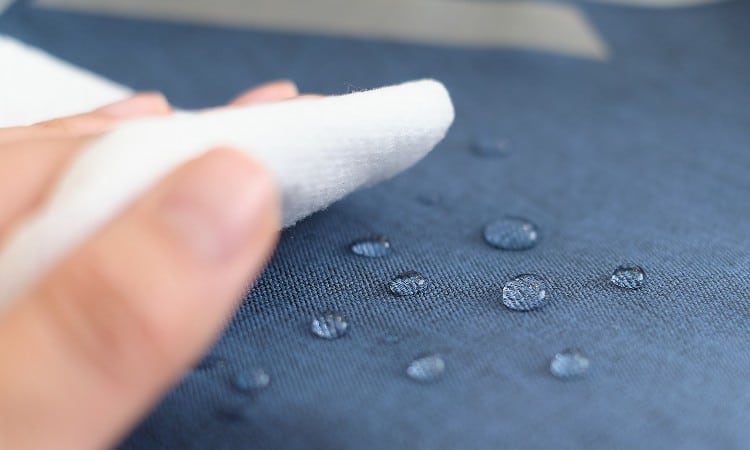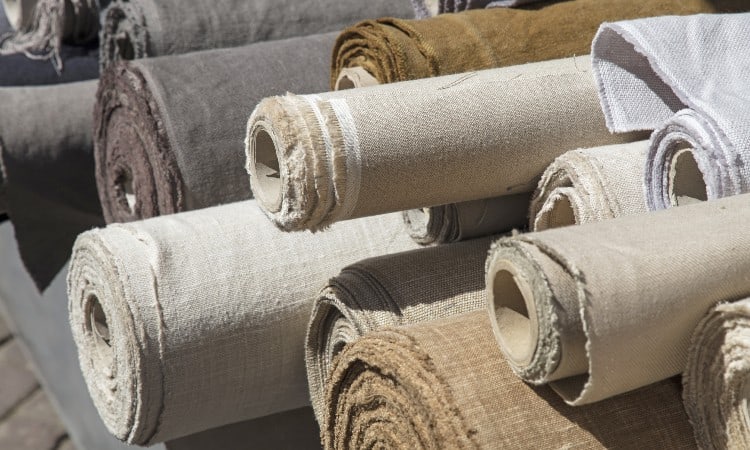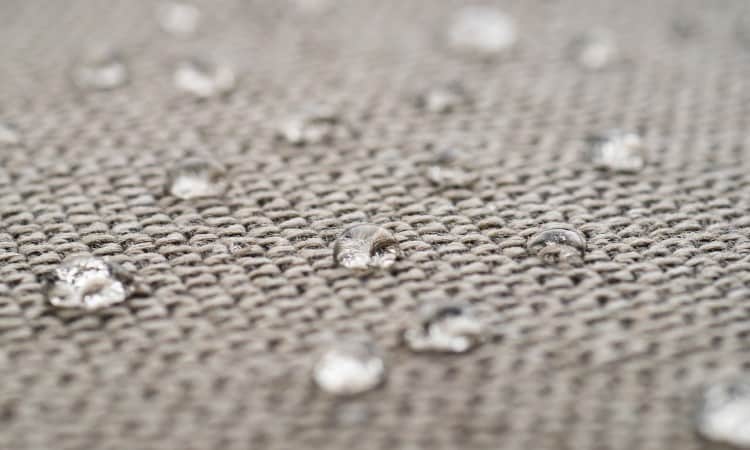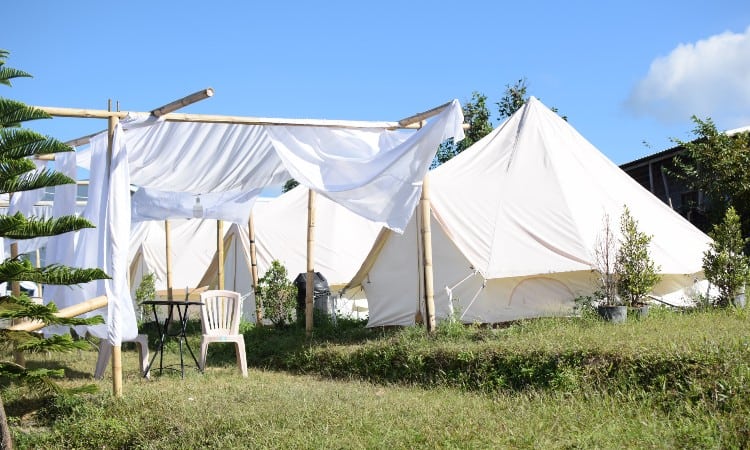If you own canvas shoes, jackets, boat equipment, or outdoor awnings, you do not want rain or moisture leaking through the fabric! Moisture buildup in the material can cause mildew later on. So, how can you waterproof canvas?
The best way to waterproof canvas is to use a silicone or petroleum sealant to waterproof the material for up to two to three years. All-natural waterproofing methods include applying beeswax or linseed oil to the fabric. Some types of canvas have natural water resistance and can repel rain without any extra treatments.
In this article, you will learn the key characteristics of canvas fabric. You will discover five easy ways to waterproof this material. Finally, you will find tips for how to waterproof canvas shoes, jackets, and outdoor equipment.

Quick Navigation
Can Canvas Get Wet?
Cotton canvas can get wet, but it will absorb the moisture instead of repelling it. The fabric will provide some protection from the elements, but it will not stay dry like a waterproof material.
What happens if canvas material gets wet? Traditional canvas fabric made out of cotton will absorb water when it gets wet. The tightly woven, dense threads in this type of cloth will swell up as they absorb the moisture.
The swollen fabric creates a solid barrier, providing limited protection for anything beneath the canvas. If you wear a canvas work jacket outside in the rain, it may keep you dry! But the fabric will become soggy and heavy if it gets too wet. Traditional cotton canvas is not a great choice for wearing in the rain or using as a canopy outdoors.
The high absorbency rate of the densely packed cotton fibers means that the fabric will soak up all of that moisture. The damp fabric will feel heavy and unpleasant after a while. Plus, the moisture may later lead to mildew or molding.
So how come canvas awnings, boat equipment, and workwear remain so popular? Well, you can use two popular methods to make canvas safe for use in wet weather. First, you can purchase modern fabric versions that mix cotton fibers with synthetic fibers like polyester.
The synthetic fibers have high water resistance and can help prevent moisture soaking into the dense cotton. You can also buy canvas made entirely out of polyester or acrylic, which has very high water resistance.
The other popular way to make canvas safe for use in a wet environment is to treat the fabric with a DWR or durable water repellent. You can use natural treatments like wax or commercial sprays containing synthetic materials for this purpose.
Is Canvas Waterproof? Water-Resistant?

Untreated canvas fabric is not waterproof or even fully water-resistant. In most cases, the canvas used for workwear, outdoor equipment, or furnishings receives special treatments to give it a water-repellent surface. You can also find some types of canvas that contain a blend of cotton and polyester fibers, which better repels moisture.
Does canvas stop the rain? This fabric can stop rain just fine, depending on what kind of water-resistant treatment you use on it. One easy way to see if your canvas jacket is water repellent is to mist it with a hose or faucet and note if the water beads on top of the fabric.
The purpose of a water-repellent treatment is to make the water bead on the fabric’s surface and then evaporate back into the air instead of soaking into the fibers and making the fabric wet and heavy.
The tight, dense weave of this type of fabric makes it a great choice for durable workwear, shoes, and outdoor awnings. This material can scrape against concrete or hold up to high winds.
People have used canvas for all kinds of outdoor activities for centuries because of its durability! But even hundreds of years ago, the canvas received a beeswax coating to make it more water-resistant.
Fortunately, you can give your canvas jacket or shoes a DWR coating yourself even more easily today with the help of a few simple supplies!
How to Waterproof Canvas: 5 Methods

You can waterproof canvas using five methods of applying coatings or sealants. If you like all-natural processes, try the beeswax or linseed oil methods. If you prefer a quicker method using synthetic sealants, try using silicone or polymer-based spray or any popular commercial sealants available today.
1. Wax
 Wax offers an inexpensive, all-natural method for waterproofing canvas. Today, only a few high-end brands sell clothing or gear coated in protective wax. A few decades ago, wax served as a much more common waterproofing and people used it all the time for coats, shoes, and boating gear!
Wax offers an inexpensive, all-natural method for waterproofing canvas. Today, only a few high-end brands sell clothing or gear coated in protective wax. A few decades ago, wax served as a much more common waterproofing and people used it all the time for coats, shoes, and boating gear!
You can use a wax waterproofing coat on canvas clothes, shoes, or outdoor gear. You can also use wax on many types of fabric, including many kinds of upholstery material, to provide an effective moisture barrier.
- First, you will need two types of wax: beeswax pellets and paraffin wax. You can order these online or find them in the candlemaking section of most craft stores.
- Next, you need a double boiler to melt the wax without burning it. You can buy a double-boiler, but you can also jury-rig this quite easily by finding two saucepans stacked on top of each other. Add one or two inches of water to the bottom pot and then set the top pot over it.
- Heat the water so that the steam will get trapped between the two pots.
- Place four ounces of beeswax pellets in the top saucepan. Add four ounces of paraffin wax to it. If the paraffin comes in a chunk, chop it into small pieces so that it will melt at the same rate as the beeswax pellets.
- Stir the wax until it melts into a smooth, thick soup.
- If you have a small canvas item like a bag, shoes, or a jacket, put it in the dryer for ten minutes to warm the fabric. You can skip this step if you plan to treat a large item such as an awning.
- Quickly use a lint roller or sticky roller to lift away any fuzz or dust from the fabric. This could interfere with the wax coating.
- Use a small, cheap paintbrush to brush the melted wax onto the surface of the canvas. After this, you will need to throw away the brush, so don’t waste a good paintbrush!
- Worm in small strokes and cover a small section of the fabric at a time to make sure you carefully brush wax over every inch of the fabric.
- Use a hairdryer to remelt the wax and allow it to soak into the fabric. To do this, sweep the hairdryer back and forth close to the surface of the canvas. You will see the wax melting again as you do this.
- Turn off the hairdryer and let the material cool entirely. When you can safely touch the fabric, check the canvas all over to see if you missed any spots with the wax. You can repeat the whole process to give the canvas a second coat if necessary.
- Finally, let the waxed canvas rest for at least 24 hours before testing it in the rain!
2. Linseed Oil
 Linseed oil offers another all-natural method for waterproofing canvas. Linseed oil comes from flax seeds and has served as a protective coating on wood and fabric for hundreds of years. You can find linseed oil in many hardware or home improvement stores and online.
Linseed oil offers another all-natural method for waterproofing canvas. Linseed oil comes from flax seeds and has served as a protective coating on wood and fabric for hundreds of years. You can find linseed oil in many hardware or home improvement stores and online.
This method works best on canvas tents, awnings, or outdoor gear rather than on clothing. Linseed oil is non-toxic but can cause bad allergic reactions.
- Cover a large work area such as a patio or garage floor with a tarp. Arrange the canvas item as flat as possible on top of the tarp.
- Use a lint roller to get any dust or fuzz off its surface before you begin.
- Wear rubber gloves to protect your hands as you soak a clean rag in linseed oil.
- Wipe the wet rag over the canvas, covering every inch.
- Let the canvas sit for half an hour to absorb the oil. Then use a clean, dry rag to wipe away any extra oil.
- Let the oil coating rest for 24 hours.
- Next, flip over the canvas and apply the same treatment to the back of the material.
3. Silicone
 Many waterproofing sprays use silicone to create a water-resistant barrier on the surface of the fabric. Typically you have to re-apply these treatments every year or two years, as the coating wears off.
Many waterproofing sprays use silicone to create a water-resistant barrier on the surface of the fabric. Typically you have to re-apply these treatments every year or two years, as the coating wears off.
The other key thing to know about using a silicone coating is that you should only use it on pure cotton canvas. The silicone will damage the synthetic fibers in a blended canvas that contains polyester or acrylic.
On the other hand, using a silicone waterproofing spray is almost certainly the cheapest method you can use to waterproof canvas!
- Set up your canvas item in an accessible way. For flat items like a jacket, spread them out on top of a tarp. For a large item such as a tent, set up the tent to reach the whole outside surface as you work.
- Hold the spray bottle eight inches from the surface of the fabric and sweep the can back and forth slowly as you spray, making sure you cover the whole surface. For items such as a tent, make sure you spray carefully over seams in the fabric.
- Let the first coating dry for two days.
- Apply a second coating in the same manner to ensure a solid DWR coating.
4. Petroleum Sealant
 Several popular commercial sealants for fabric use petroleum as a key ingredient. You can also make your own waterproofing recipe using petroleum, beeswax, and a few other ingredients!
Several popular commercial sealants for fabric use petroleum as a key ingredient. You can also make your own waterproofing recipe using petroleum, beeswax, and a few other ingredients!
Petroleum-based products make great water repelling coatings. When you think about it, plastics and all kinds of polyester come from petroleum! Whenever you see the word “polymer” in a description, that means that the product has its roots in petroleum.
Modern “oilcloth” sold today typically contains a simple cotton fabric treated with a petroleum coating.
Brands like Starbrite offer these petroleum-based polymer sealants in a variety of forms. You can get spray bottles that work well for small projects or liquid forms that you have to apply with a paintbrush.
You will typically need to allow at least 24 hours for drying time before using the treated canvas.
5. Commercial Spray

Another popular type of commercial waterproofing spray contains fluoropolymers. Big-name brands like Gore-Tex use this kind of sealant to offer more durability than a silicone coating.
Fluoropolymers contain long carbon-fluorine structures.
This chemical structure does not fall apart even in extreme circumstances, which is why this kind of coating holds up so well!
Of course, the key reason a fluoropolymer spray works so well is that it has a non-polar structure that repels polar water molecules.
Also, this spray famously remains non-sticky and feels super lightweight.
What Kind of Canvas is Waterproof?

Canvas fabric made out of polyester or acrylic will provide a high level of water resistance even without a waterproof coating or sealant. Cotton canvas, like Duck Canvas, will not provide any water resistance unless you treat it with a sealant.
You can find canvas made out of several different materials. Each material provides varying levels of water resistance.
- Polyester canvas, often called “waterproof canvas,” contains 100% polyester fibers in a dense weave. This cloth is made the same way as traditional cotton canvas but uses synthetic polyester fibers instead of absorbent cotton fibers. This creates a highly water-resistant fabric.
- Duck canvas made from traditional cotton will soak water instead of repelling it. This means that it does not provide much water resistance at all. That said, the dense weave of this material will hold a lot of water before any moisture gets through the fabric.
- Acrylic canvas contains synthetic acrylic fibers. This type of canvas is used in awnings and outdoor structures because it has UV resistance and will not fade. It has a decent water resistance on its own but typically requires a waterproofing spray once a year.
- Silicone canvas is not canvas at all. It is more like plastic sheeting that sometimes serves in place of canvas for outdoor uses or boat parts. This material does offer excellent waterproofing abilities.
- Ottertex is a brand-name waterproof canvas made out of 100% polyester. It has a super tight weave, a PVC backing, and a waterproof coating on top of all that! This material makes excellent outdoor apparel and athletic wear.
How to Waterproof:
Now that you know how to use the five most popular methods for waterproofing canvas check out these tips to learn which method works best on bags, shoes, and tents!
Canvas Bag or Hat
 Waterproof sprays such as a silicone spray or a polymer spray will quickly coat your bag or tote without hiding any prints, logos, or cool designs on the bag. The added benefit of this method is that it takes just a few minutes to apply a spray to something as small as a bag.
Waterproof sprays such as a silicone spray or a polymer spray will quickly coat your bag or tote without hiding any prints, logos, or cool designs on the bag. The added benefit of this method is that it takes just a few minutes to apply a spray to something as small as a bag.
If you have a plain canvas bag or a bag in a solid color, you may also want to consider a quick, all-natural wax treatment using OtterWax cubes. This interesting method does not require melting and brushing on the wax. Instead, you just rub the soft bar over the surface of the fabric!
Canvas Shoes
The best way to waterproof canvas shoes is to use the melted wax method. This allows you to brush wax into every nook and cranny and pay close attention to seams, holes for laces, etc.
You don’t have to worry about matching the right type of synthetic spray to the kind of canvas in your shoes if you use all-natural wax. The wax will not damage any type of canvas!
Canvas Jacket
 One of the factors you want to consider when choosing a waterproofing treatment for a canvas jacket is the smell of the product you pick. Natural products like linseed oil will leave a lingering odor, but so will many commercial products like Scotchgard!
One of the factors you want to consider when choosing a waterproofing treatment for a canvas jacket is the smell of the product you pick. Natural products like linseed oil will leave a lingering odor, but so will many commercial products like Scotchgard!
Using the melted wax method or applying a bar of OtterWax will not leave an unpleasant odor. However, these products could make the canvas jacket feel stiff and heavier. If you plan to use your canvas jacket in a tough work environment, the wax may provide an added layer of protection that works well in that situation.
Commercial sprays like Nikwax make this process even easier, though the spray is not all-natural.
Canvas Boat Cover
 To quickly waterproof a canvas boat cover, use a fluoropolymer spray. This is important because many sail covers or boat covers contain acrylic canvas, which offers UV protection and remains breathable. You should never use a silicone spray on acrylic canvas.
To quickly waterproof a canvas boat cover, use a fluoropolymer spray. This is important because many sail covers or boat covers contain acrylic canvas, which offers UV protection and remains breathable. You should never use a silicone spray on acrylic canvas.
One of the most popular coating sprays for marine use is 303 Fabric Guard. This product works on cotton and synthetic canvas and applies in a clear, unscented coating.
Canvas Tent / Tarp
 The easiest way to waterproof something large, like a canvas tent or tarp, is to use a commercial spray. You can choose a silicone product or a petroleum-based product. Make sure you follow the instructions on the product to apply the spray correctly and give it an adequate resting time to cure.
The easiest way to waterproof something large, like a canvas tent or tarp, is to use a commercial spray. You can choose a silicone product or a petroleum-based product. Make sure you follow the instructions on the product to apply the spray correctly and give it an adequate resting time to cure.
These days, most tents come with a protective waterproofing, but you may want to re-treat for added security. Plus, after a year of use, you will need to reapply a coating anyway!
Camp Dry Spray has many loyal followers as a long-standing brand offering good waterproofing. This silicone spray works best on outdoor equipment like tents, tarps, and awnings. Remember that you should never use a silicone spray on canvas that contains acrylic!Mainstream brands like Scotchgard use a mix of petroleum-based polymers and organofluorine chemicals to create a variety of protective features, including waterproofing, UV protection, and stain resistance.
As a pro tip, you may also want to apply waterproof tape to the seams in a tent. Waterproofing sprays will work pretty well over these areas, but for 100% certainty that you won’t get soaked in a thunderstorm, sealing up connecting areas in the tent with special waterproof tape works best.
Canopy
When you buy a canopy or awning for your house, boat, or patio, it typically comes pretreated with a waterproof sealant. What you may not know is that the treatment usually only lasts for about a year! After that, you will probably notice water leaking through the awning at seams and corners.
To solve this problem, you need to thoroughly clean the canopy and then apply a new waterproof coating. For something big, the best option is usually a spray-on coating. You will want to select a polymer-based or fluoropolymer spray for this process because most canopies and awnings do use acrylic canvas. The acrylic canvas has a better UV protectant than any other kind, protecting it from fading over time.
Best Waterproofing Spray for Canvas Fabric
 If you decide to use a commercial spray to waterproof your canvas, two of the most popular types on the market are 303 Marine Fabric Guard and Scotchgard.
If you decide to use a commercial spray to waterproof your canvas, two of the most popular types on the market are 303 Marine Fabric Guard and Scotchgard.
303 Fabric Guard offers several waterproofing products for fabric. The 303 Marine Fabric Guard, available in refill and spray canisters, works perfectly for canvas items on a boat. This includes boat covers, sail covers, and sails! This odorless, colorless product adds a protective barrier to the fabric that repels water and blocks stains.
303 Fabric Guard products work equally well on cotton or synthetic canvas fabrics. You can use the product for outdoor gear or protect upholstery, patio furnishings, or awnings!
Another super-popular waterproofing spray for canvas is the Scotchgard line of products. These sprays are silicone-based, so you should avoid using them on acrylic fabrics. They can also leave streaks if you apply them too heavily, so make sure you follow the instructions on the package.
Scotchgard Heavy-Duty Fabric Spray provides a quick and easy water repellent to coat almost all fabric surfaces. It dries in a breathable, odorless clear coat over the fabric. You can use this product on canvas tents, backpacks, canopies, or patio cushions!
One 13 oz spray can of this impressive formula covers up to 60 square feet of canvas! You will need to reapply the product seasonally for the best waterproof protection, though.
How to Maintain Waterproof Canvas
No waterproofing treatment lasts forever, so you will need to learn how to maintain your waterproof canvas no matter how good a job you did the first time around!
Commercial products like silicone sprays or petroleum-based treatments will generally come with maintenance instructions. Most commercial sprays require reapplication once a year.
Here are some tips to help you maintain your waterproofing:
- Make sure you clean the surface of the fabric thoroughly before reapplying for the product of your choice. Suppose you want to maintain the waterproofing on a boat cover or awning. Think about all the pollen, dirt, and dust it could have accumulated during the past year!
- Use the same product you used before. In some cases, mixing products could damage the canvas.
- If you have a household calendar, set an annual reminder for maintenance, just like you do for air filters inside your house!
What is the Best Canvas Waterproofing
The best canvas waterproofing depends on the type of canvas, the purpose of the canvas item, and your own preferences.
First, consider the kind of canvas material you have to start with.
If you have a 100% cotton canvas, you need to apply a waterproof sealant to protect the fabric. If you have a pre-treated canvas tent, you will want to reapply the appropriate product as recommended by the tent manufacturer. If you want to waterproof a garment such as a jacket, you will want to pick a product that does not smell bad as you wear the jacket!
Second, how do you plan to use the canvas item? Boat covers and awnings need pretty intense waterproofing as well ass AV protection. Canvas bags and totes need a light waterproof coating such as waxing or a silicone spray because they will not see such intense use.
Finally, you also want to consider your own preference for all-natural vs. chemical treatments. If you want to go all-natural, you should use a wax melt or linseed oil coating. If you want a quicker, cheaper method, try using a polymer-based spray like the Scotchgard products for an easy synthetic solution!
What kind of canvas item do you plan to waterproof? Have you decided what kind of waterproof treatment to use? Leave a comment below to let us know!